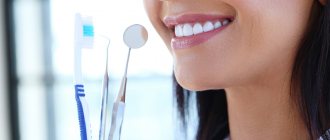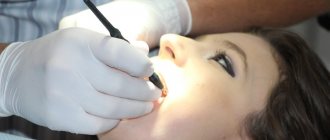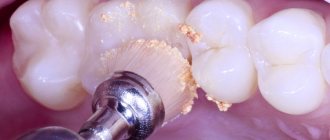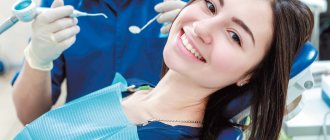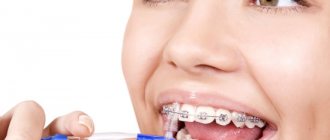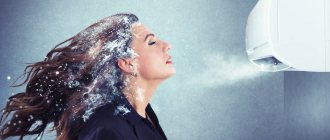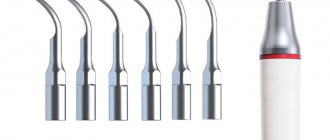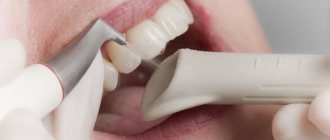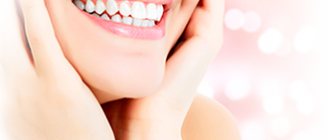What is professional teeth cleaning at the dentist?
Oral care can be done both at home and in the dentist's office. Daily home care does not completely eliminate the risk of oral diseases. Therefore, during regular dental examinations, you should periodically have your teeth professionally cleaned.
Modern cleaning methods allow you to remove all plaque from the enamel and remove existing tartar in a short time. At the same time, the teeth are restored to their natural whiteness and various oral diseases are prevented.
The professional teeth cleaning procedure is painless. Its main advantage, in addition to the removal of visible dental plaque, is the reduction of pathogenic microflora in the oral cavity and the increase of local immunity.
What is plaque and tartar?
Dental plaque is essentially a mass of food debris, saliva, pathogenic microorganisms and their waste products. Daily brushing removes plaque only on open and easily accessible areas of the teeth. In places that are difficult to clean independently, plaque accumulates in large quantities. This is, first of all, the cervical area of the teeth, fissures on the chewing surface and the gingival groove.
After a few days, the plaque turns into a hard plaque. The concentration of harmful microorganisms in it is 50% higher than in unhardened plaque. Such a plaque cannot be washed off with saliva or water. The plaque gradually grows and a very dense deposit is formed from it - tartar. This education contributes to the development of periodontal diseases (periodontitis and periodontal disease) and caries.
Oral hygiene in dentistry: what is included in the procedure?
In general, oral hygiene in dentistry is a complex event, which includes several procedures at once. Let's consider all these procedures in detail.
Inspection
The patient comes to the dentist, to the doctor’s office, and the specialist conducts a thorough examination of the oral cavity, determining the indications for professional hygiene and eliminating possible restrictions on its implementation. Also during the inspection, a cleaning method is selected. There are several technologies for removing plaque, and we will also tell you about them in a separate section of the article.
Cleaning
To remove hard and soft plaque during dental and oral hygiene, different techniques can be used. Each of them has its own characteristics, pros and cons, which are best familiarized with in advance.
Mechanical cleaning
This method is rarely used in modern dentistry for dental and oral hygiene.
It involves the use of hand-held, outdated instruments that can easily injure the sensitive soft tissues of the oral cavity. The only and very relative advantage of mechanical cleaning is the low price of the service. Photos before and after:
Ultrasound technique
This technology for removing plaque is considered the most modern and safe.
In it, the doctor will use a special installation and instrument - an ultrasonic scaler. This device is capable of creating ultrasonic waves of controlled frequency that destroy not only soft and pigmented plaque on dental surfaces, but also hard tartar. Photos before and after:
Ultrasound is capable of removing plaque not only on dental surfaces, but also in the most inaccessible areas, including periodontal pockets. Such ultrasonic cleaning capabilities are especially in demand when carrying out dental and oral hygiene in patients with periodontitis and periodontal disease.
Air-abrasive technique Air Flow
With this type of teeth and oral cavity cleaning, a special device is used that delivers a powerful water-air jet saturated with small abrasive particles to the dental surfaces.
Air, water and fine abrasive ideally remove soft and pigmented plaque and cleanse the area of periodontal pockets. The Air Flow technique is one of the most modern technologies for dental and oral hygiene; it is painless, does not injure tooth enamel, and has a minimum of contraindications.
Photos before and after:
USEFUL TO KNOW: Most often, Air Flow and ultrasonic cleaning are used in combination, because the first technology perfectly copes with soft and pigmented plaque, but is practically useless against old tartar.
Another cleaning technology used in modern dentistry is the laser technique. It uses a directed laser beam, which not only destroys plaque, but also destroys all pathogenic microflora in the oral cavity. The laser cleaning procedure is safe, it does not harm tooth enamel, and does not cause increased sensitivity of teeth and gums. In addition, laser cleaning promotes accelerated healing of various microcracks and wounds present in the oral cavity.
What cleaning method will be used in your case? You will decide this issue together with your doctor, because each method of cleaning dental surfaces during dental and oral hygiene has not only indications, but also contraindications.
But cleaning dental surfaces is far from the final stage of professional dental and oral hygiene procedures. After removing plaque, you will need to carry out the stages of polishing and grinding the surface of the teeth and remineralizing the tooth enamel.
Polishing
Polishing of dental surfaces is a mandatory step in dental and oral hygiene in dentistry.
High-quality polishing of teeth gives them a beautiful shine and perfect smoothness, thanks to which plaque does not accumulate on the enamel. The polishing stage is carried out during dental and oral hygiene with a specialized instrument.
Remineralization
Remineralization is a procedure that represents the final stage of dental and oral hygiene.
During this stage, the specialist treats the surfaces of the patient’s teeth with preparations containing fluoride and calcium. This treatment prevents the occurrence of unpleasant hypersensitivity of teeth, acts as an excellent prevention of caries, and in addition helps to strengthen and restore tooth enamel. Oral and dental hygiene ends with a detailed consultation with a doctor. The dentist explains in detail to the patient what dental care should be like after the procedure, and assists in choosing products and tools for everyday dental hygiene.
What are the indications for professional teeth cleaning at the dentist?
It is recommended to consult a dentist for such a procedure in the following cases:
- The need to eliminate tartar in both supragingival and subgingival locations;
- Removing hard and soft plaque;
- For the prevention of diseases of hard dental tissues (caries and non-carious lesions);
- Treatment and prevention of periodontal diseases (gingivitis, periodontitis, periodontal disease);
- Elimination of bad breath;
- Prevention of the development of periodontal bleeding;
- As the first stage of the teeth enamel whitening procedure.
The frequency of the procedure is recommended once every 6 months, but more often is possible. Modern methods of professional teeth cleaning are very gentle and do not have a negative effect on the oral cavity or to a minimal extent.
You can independently determine when you need to visit a clinic for professional cleaning by looking at the following negative signs in the oral cavity:
- Bad breath, but gastrointestinal diseases have not been diagnosed;
- There is bleeding gums, itching and burning in the mouth;
- Visual presence of tartar;
- The tooth may hurt;
- Change in periodontal color (cyanosis or hyperemia);
- There is subsidence of the gums, they may bleed;
- There is a feeling of heaviness and pain in the periodontium when chewing food, especially sour or spicy;
- There is a violation of the periodontal attachment.
It should be noted that there are practically no contraindications for professional teeth cleaning. There are only general relative limitations, such as the acute stage of inflammatory processes in the body.
The basic methods of professional teeth cleaning are based on a modern correct approach to the problem and involve a complex effect during the process of professional teeth cleaning at the dentist. At the same time, manual and hardware cleaning methods are distinguished.
Hardware methods of teeth cleaning
Professional oral cleaning is performed by periodontists or hygienists. The procedure is preventive and does not require special preparation; in extreme cases, local anesthesia is performed. Of the hardware methods, the following techniques are the most popular.
Cleaning teeth at the dentist using the air flow method
During the cleaning process using the Air Flow method, hard dental deposits are exposed to abrasive material and a powerful stream of directed air. The abrasive commonly used is sodium bicarbonate. Cleaning takes place simultaneously with the supply of a thin stream of water. For an additional refreshing effect, different flavors (mint, lemon or menthol) are added to the water.
Cleaning occurs due to soda particles, which hit the enamel at high speed, removing both soft and hard plaque. At the same time, the supplied stream of water washes away the removed deposits and stones so that they do not interfere with further exposure. Water also helps reduce the heating of tooth enamel that occurs during this manipulation.
The Air Flow technique helps not only to eliminate plaque, stones and pigmentation, but also to thoroughly polish the enamel, at the same time ensuring its partial lightening. However, it should be remembered that air flow cannot whiten tooth enamel by several tones. After manipulation, hard tissues will only acquire their original color.
Reviews about Air Flow are in most cases positive, since the main advantages of the technique include:
- Availability;
- Safety;
- Painless;
- High efficiency.
The entire effect takes no more than 30 minutes. Moreover, the air flow is selected individually for each patient. And the power directly depends on the volume of dental plaque that needs to be removed. In addition, the thickness of the enamel and the individual sensitivity of the teeth are taken into account.
Despite the positive aspects of professional teeth cleaning using the Air Flow method, there are quite significant contraindications to this method. First of all, these are diseases of the respiratory tract. These include:
- Obstructive bronchitis;
- Bronchial asthma;
- Allergy to airflow components;
- Acute periodontal and hard tissue diseases;
- Multiple caries;
- Thin layer of enamel;
- Non-carious lesions associated with increased sensitivity of enamel and its excessive fragility.
The cost of the procedure in dental offices is usually not high and is affordable for everyone. In just 3-4 thousand rubles you can get a good preventive effect using the Air Flow method, as well as additional services to strengthen the hard tissues of teeth. The effect after the procedure lasts depending on the patient’s lifestyle and the absence or presence of somatic diseases. In any case, it is advisable to visit the dentist again no later than six months later.
Benefits and harms
There is a lot of controversy about this procedure. Many patients consider it necessary and note many advantages, others tend to think that it is dangerous to health. Dental experts are unanimous in their opinion: hygienic cleaning is useful, but in moderation. With frequent use, it can aggravate the patient's condition.
Benefits of professional cleaning:
- The unpleasant odor disappears.
- Along with deposits, pathogenic microflora and other causative agents of inflammatory processes in the oral cavity are removed.
- The enamel becomes smooth and absorbs beneficial microelements contained in food and toothpaste much more efficiently.
- The condition of the teeth visually improves - the smile looks brighter, the natural color returns to the teeth.
- The procedure is indispensable for gingivitis, periodontitis and other gum and dental diseases. It is practically the only way to treat them.
The disadvantages of cleaning include:
- When removing subgingival plaque, gum damage may occur. Microtrauma is usually accompanied by bleeding and pain. However, the symptoms disappear after a couple of hours, and complete restoration of the soft tissues is observed within 7 days.
- Unpleasant sensations are possible. In most cases, the manipulation is painless, but for 2% of people suffering from hypersensitivity, anesthesia is performed.
- Ultrasonic cleaning is undesirable for patients with serious pathologies of an infectious nature, asthma, heart disease, bronchitis, with artificial heart valves or implants, as well as children and adolescents. If cleaning with high-frequency sound waves is contraindicated, use an alternative option - abrasive.
In order not to harm the enamel, it is recommended to carry out the procedure twice a year (the interval between sessions should be 6 months). An exception is patients with removable dentures, bridges and crowns. They develop plaque more actively, so cleaning must be done 3-4 times a year.
Ultrasound teeth cleaning method
The effect of ultrasound on tartar greatly facilitates the process of their removal. The procedure is faster and less tiring for the patient; it can be used to remove both subgingival and supragingival deposits. An important advantage of ultrasound is its antibacterial and antimicrobial effect on almost all microorganisms in the oral cavity.
The ultrasound waves used for cleaning are completely safe for the oral cavity. In addition, there are various attachments for the emitter that allow you to most effectively remove plaque and tartar even in the most difficult areas of the jaw. In this case, the tartar not only flakes off, but is also partially destroyed. What is important when removing it from periodontal pockets, since instrumental treatment of these places will be quite traumatic and painful for the patient. The gentle impact of ultrasound allows for a gentle effect on tooth root cement and enamel.
In parallel with ultrasonic vibrations, a stream of liquid is supplied to the oral cavity, washing away all remnants of stones and plaque from the interdental spaces and gum pockets.
Usually, just one session of professional teeth cleaning with an ultrasonic dentist is enough to remove all hard and soft deposits. In addition, this also causes partial lightening of hard tissues.
This cleaning method has practically no disadvantages, however, there are contraindications to ultrasonic teeth cleaning:
- A pacemaker installed in the patient;
- The presence of renal, pulmonary and liver failure;
- The presence of cardiovascular diseases in a severe stage;
- Extensive demineralization of enamel;
- Purulent diseases of periodontal and oral mucosa;
- Installed orthopedic structures, especially those made using metals;
- Multiple caries and its various complications with the formation of purulent exudate.
Ultrasonic teeth cleaning is very accessible in dentistry, which is explained by the following points:
- There are many companies offering devices for this method in dentistry;
- The cost of services using ultrasound is not very high. Many dentists offer professional teeth cleaning with ultrasound at a price from 1200 to 4000 rubles, the cost varies depending on the amount of work.
The effect of the ultrasonic cleaning procedure lasts for at least 1 year, provided the patient follows the recommendations for careful home dental care.
Features of two professional hygiene methods: advantages and disadvantages
The main task of ultrasound exposure is to remove soft and hard plaque using a special tool, a scaler. It creates ultrasonic vibrating waves that precisely treat the space, separating tartar from the enamel. At the end of the procedure, the oral cavity is washed with water, and the crushed particles are removed along with the liquid. This technique allows you to cope with bacteria that accumulate in the space between the teeth. In total, the procedure takes no more than 40 minutes, is carried out without the use of anesthesia and gives an effective result immediately after completion of the dentist’s manipulations.
When comparing ultrasonic cleaning and Air Flow, it is worth focusing on the advantages of the first:
- The technology is safe, as it is implemented without toxic agents that can negatively affect teeth and mucous membranes. The technique does not involve direct contact.
- The ultrasound technique is guaranteed to remove tartar, which cannot be done by carrying out regular hygiene procedures at home.
- The scaler removes not only obvious tartar, but also that which forms in the subgingival area and in pockets, which avoids inflammation of the mucous membrane.
- After the procedure, the teeth regain their natural color, because the enamel becomes a couple of tones lighter due to the elimination of plaque and impurities.
It is worth keeping in mind that this technology is contraindicated in the presence of installed orthopedic systems, implants and prostheses. The first trimester of pregnancy is a contraindication to the procedure.
Understanding the difference between Air Flow and ultrasonic cleaning, you should also identify the advantages of the second method. Air Flow is designed to remove pigmentation and soft plaque. During the work, the doctor uses a sandblasting machine, which removes deposits that have not had time to harden and become tartar. The procedure is carried out using a solution of water and soda. A directed jet of liquid is applied to the teeth, sweeping away dirt and polishing the tooth surface, thereby achieving the desired effect.
The technique has the following advantages in comparison with alternative techniques:
- Does not require anesthesia, as the patient does not experience any discomfort or discomfort.
- Soda crystals do not scratch enamel and do not damage teeth and mucous membranes.
- Soft plaque is removed from the teeth and the space between them, as well as from the gums.
- The technique can be used in the presence of dentures, implants and crowns.
Unlike ultrasonic teeth cleaning, Air Flow does not remove hard plaque or tartar, which is a significant disadvantage of the procedure. The technology does not eliminate harmful microorganisms that provoke inflammation of the mucous membrane and does not help fight subgingival deposits.
Laser therapy method for teeth cleaning
The laser therapy technique is the most modern today. Its effect is based on the evaporation of liquid. The fact is that there is much more of it in plaque and tartar than in enamel. The laser, evaporating liquid from deposits, allows you to destroy the stones layer by layer.
Hygienic cleaning of teeth with a laser is carried out at a distance, without contact of instruments with oral tissues. Thus, this technique is completely painless. When it is carried out, there is no chance of infection, and the laser itself has an antiseptic effect.
Another advantage of laser cleaning at the dentist is that it helps to further whiten the enamel. Thanks to this, there is no need for another procedure. In addition, the light flux has a bactericidal effect and effectively fights pathogenic microorganisms, helps in the regeneration of wounds and prevents the development of caries. The entire procedure does not require any special preparations and is painless for the patient.
Laser teeth cleaning is contraindicated under the following conditions:
- Rhinitis and ARVI;
- The presence of implants, including pacemakers, in the patient’s body;
- Severe infectious diseases (HIV infection, tuberculosis, hepatitis);
- The presence of orthopedic structures in the oral cavity;
- The patient has a history of epilepsy and asthmatic attacks.
Manual professional teeth cleaning
With an integrated approach to teeth cleaning, the manual method is used last by dentists. With it you can:
- Smooth out roughness caused by plaque;
- Eliminate plaque and tartar residues in difficult-to-treat areas of the oral cavity;
- Remove surface pigmentation from food dyes on enamel;
- Treat interdental spaces;
- Stop the development of pathology in the periodontium.
Manual teeth cleaning is the final stage of the entire procedure and is carried out using various instruments. The most popular are strips - special strips with a rough coating. Using strips, the dentist eliminates all errors caused by hardware in the interdental spaces. Floss or dental floss is used in the same way.
Brushes with polishing pastes are quite popular, effectively removing even very old plaque and stones. For a more powerful impact, instruments such as curettes are used. They are produced to work in a wide variety of groups of teeth. They have a very sharp working surface, so if used correctly they can remove all deposits as effectively as possible.
Effect of professional cleaning on dental restorations
AirFlow affects restorations in the same way as it does on your own teeth - it removes attached plaque and creates slight roughness. Ceramic and metal structures normally have a surface smoothness higher than the enamel of your own teeth. Plaque sticks to them much less often, and there is no need to treat them at all if there is no need. If, nevertheless, air-abrasive treatment of ceramic, metal-ceramic or metal crowns is required, then they should be polished not with a brush and toothpaste, but with a special polishing set.
Separate polishing agents are also used for fillings, plastic, composite or metal-plastic crowns. These materials are less smooth than tooth enamel, and therefore accumulate plaque faster. Grinding the outer layer of such restorations can slightly improve their appearance, since these materials themselves darken over time, and the darkening is most pronounced in the superficial areas. However, the painted border between the filling and the tooth is not always eliminated in this way.
Ultrasonic treatment can lead to the loss of low-quality restorations. Even if the filling looked good outwardly and did not create any problems, its loss during ultrasonic cleaning indicates that adhesion to the tooth has already decreased to its minimum values. After some short time, such a filling would fall out on its own. But a dentist will not remove a high-quality restoration with an ultrasound, even if he really wants to and spends the whole day working on it.
Metal ultrasonic attachments are used to clean teeth. Composite fillings can become stained upon contact (the resulting streaks can then be easily sanded off). Contact with a metal ultrasonic tip is contraindicated for ceramic restorations (crowns, inlays, onlays, bridges) as cracks may form. For their processing, special polymer ultrasonic tips are used that do not damage the ceramics. The same attachments are used when cleaning implants.
Rice. 6. Ultrasonic tip for implants and ceramic restorations.
Oral care after professional teeth cleaning
During the first 24 hours after professional teeth cleaning, patients are not recommended to eat foods with pronounced coloring components. It is advisable to give up strong coffee, tea and smoking. Also, during the appointment, the dentist must apply special products to prevent the formation of deposits and strengthen the enamel.
After eating, you need to brush your teeth or at least rinse your mouth with water, eat an apple or chew gum. Today there are a large number of toothpastes that actively prevent the formation of any deposits. It is advisable to have them recommended to you by your dentist.
All this will help not only avoid the formation of tartar, but also prevent many diseases of the periodontium and hard dental tissues.
Benefit
Contrary to popular belief, there is currently no evidence of the usefulness of occupational hygiene in preventing caries.
But professional cleaning is a good prevention of periodontitis. Moreover, for gingivitis and mild forms of periodontitis, it may be the only treatment method. By eliminating tartar, inflammation of the marginal gums is relieved - thus the periodontal condition is normalized, and other methods of treatment are not required.
Removing supragingival dark pigmented plaque improves appearance. Sometimes even professional hygiene is confused with bleaching. When whitening, the structure of tooth tissue changes chemically; when brushing, it only removes plaque adhering to the surface (the color of the teeth itself does not change, but visually they look lighter than with dark plaque).
